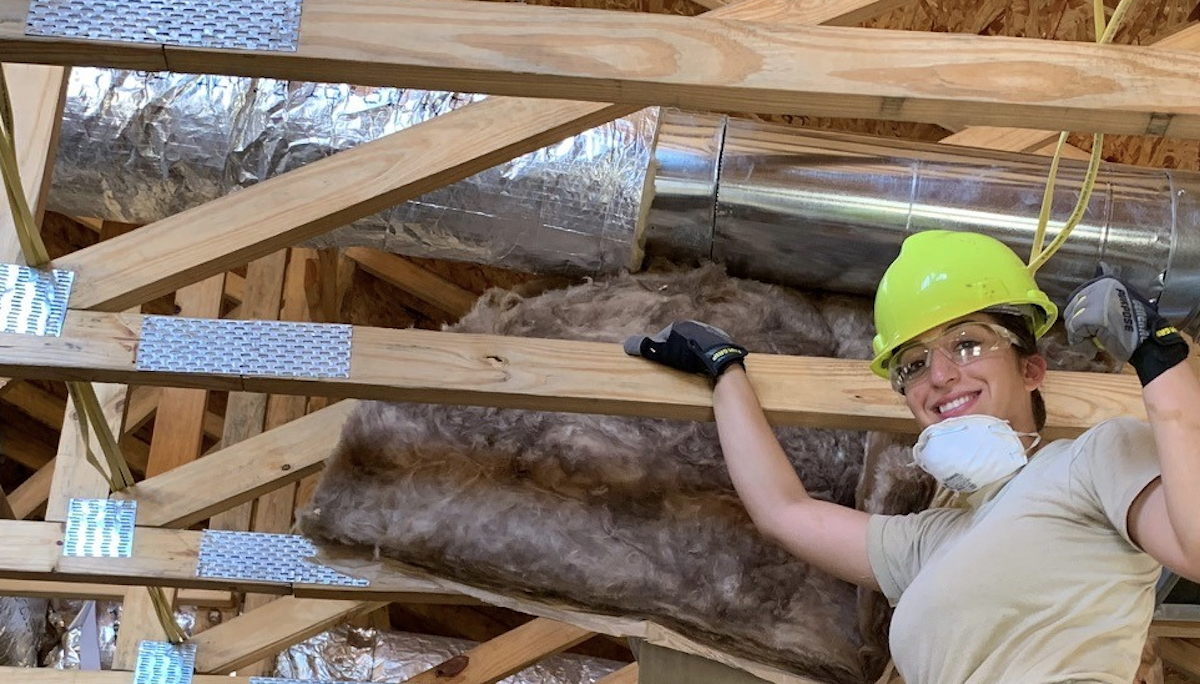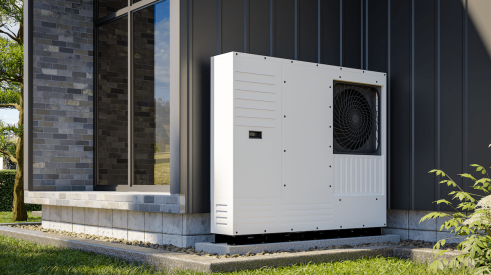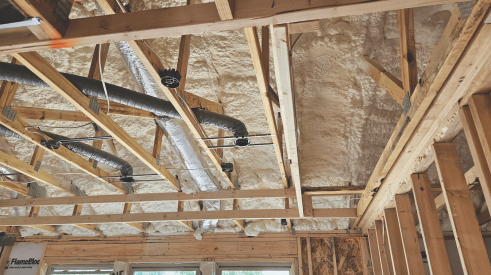Energy loss in ductwork can account for as much as a quarter of heating and cooling energy needs of a house, according to the U.S. Department of Energy. For this reason, a growing number of home builders have adopted interior-duct HVAC schemes, where the vital HVAC-related systems, including the ductwork and HVAC equipment, are housed within the conditioned shell of the home. The resulting system can reduce energy use by as much as 20 percent compared to typical HVAC installations and potentially improve occupant comfort.
The Earth Advantage Institute (EAI), a nonprofit organization dedicated to steering the building industry toward and helping builders implement greener practices, recently worked with more than 575 builders and contractors in the Pacific Northwest on designing and implementing interior HVAC systems. A select number of participating builders later implemented interior-duct schemes and reported on any challenges and lessons learned in the process. The EAI, with funding from the Northwest Energy Efficiency Alliance and the DOE, then compiled the feedback from the participating builders and reported the findings in a series of case studies.
RELATED
- Getting HVAC Right: Consider These Tips When Sizing and Specifying
- Why Compact Duct Layouts for HVAC Make Sense
- How Advances in HVAC Are Affecting Indoor Comfort and Occupant Health
“We pitched ducts inside as an easy way to move into the future of building standards, especially since the new Energy Star requirements took effect in January 2012,” says Bruce Sullivan, a green-building consultant for EAI who managed the program. “Putting ducts inside is a really good way to achieve these standards –– one new practice and you basically get all the savings you need to meet the requirements.”
Professional Builder spoke with several builders involved in the program to hear their feedback on implementing interior HVAC systems. Here’s what they had to offer.
Advantages of Interior Duct HVAC Systems
“We didn’t encounter any negatives,” says Scott Flynner, owner of the Flynner Building Company, Boise, Idaho, who implemented his first interior HVAC system as part of the EAI program and plans to incorporate the scheme in all future homes by using conditioned crawl spaces. Flynner says because the ductwork is inside the home and not in an unconditioned attic or crawl space, the only air circulating is the air within the house.
12 Facts About Interior-Duct Schemes
Thinking about implementing an interior-duct design scheme for your homes? Before you begin, the NAHB Research Center offers the following tips to help you determine if this building technology approach is right for you. For more, visit www.ToolBase.org and look for the “Ducts in Conditioned Space” tech sheet.
- Placing ducts in conditioned space is most beneficial in extreme climates, but is suitable and effective for all climates. The potential for condensation is reduced in humid climates.
- The practice is easier to implement in single-story homes and in multi-story homes with open-webbed floor joists. It is appropriate for retrofitting, but it might be challenging to find areas to run ducts in existing homes.
- When used in conjunction with HVAC equipment in conditioned space, interior ducts can be an integral part of a universal design because owners have easy access for changing filters.
- If you build crawl space foundations, investigate the possibility of building a “short basement” rather than a ventilated crawl space. This technique simplifies the practice of bringing ductwork and equipment into conditioned space.
- In a well-insulated and sealed house with energy-efficient windows, supply registers can usually be located on interior walls, thereby reducing duct length. Keeping duct runs short not only reduces material use, but also improves the efficiency of the duct system.
- In a carefully designed duct system in which duct length is minimized, duct diameter can often be reduced, thereby reducing costs and making it easier and less obtrusive to run ducts through interior spaces.
- Material savings from efficient duct design can help offset additional costs associated with bringing ducts into conditioned space.
- When transfer grilles are used, homeowners may be concerned about noise transmission through the walls.
- If ducts are routed through open-web floor joists, it is essential that rim joists be sealed and insulated.
- If ducts are perpendicular to floor joists, and open-web trusses are not used, it may be necessary to construct bulkheads for duct runs.
- Trade contractor schedules (e.g., carpenters, HVAC installers) may need to be reworked to accommodate the practice.
- Practical considerations may necessitate running some ductwork in unconditioned space.
Source: ToolBase TechSpec: Ducts in Conditioned Space, ToolBase.org
“One benefit is that you can downsize your furnace because now your house is more energy-efficient,” Flynner says. “When the ducts lose energy, they lose it to the house itself, not to the atmosphere. The only loss of energy is through the envelope.”
The size of the ductwork can be reduced as well, says Nathan Phillis, owner of Pyramid Heating and Cooling, Portland, Ore. Reducing the length of the duct system in turn reduces costs of the ducts themselves and the amount of labor needed to install them; it also increases efficiency.
“You have much more balanced rooms in terms of heating and cooling distribution,” Phillis says. “Sometimes in a house in which the ducts run through the attic, you have a room that’s 50-plus feet away from the ducts and you never get the heating or cooling that you would like in that room.”
Indoor air quality is also improved, according to Steve Asher, owner of Asher Homes, Ashland, Ore. “As we improve the airtightness of our building envelopes, leakage in the duct system becomes more amplified,” Asher says. “Even small leaks in the return side of a duct system can bring in pollutants and contaminants from the crawl spaces or attics of homes, where the ducts are traditionally run.”
Downsides of Interior Duct HVAC Systems
One drawback is that there is some square footage lost in the overall layout of the house.
“Because the furnace has to go inside the house itself, it typically takes up about a 30 x 30-inch area, so an area that would have been a coat closet or linen closet is now a furnace closet,” says Phillis.
There is a solution to this, says Jay Campbell, co-owner of Woodhill Homes, Bend, Ore. “We’ve started to have our designer draw in a dedicated mechanical room. We then insulate around it so the furnace is in a heated area. The trick is making sure you have a spot for the furnace in the beginning of the design phase so you don’t lose a closet space.”
Another potential issue is that building with ducts inside can result in a noisier HVAC system because of the shorter duct runs, says Phillis.
“With the shorter ducts, there is potentially a lot more noise transfer,” he says. “There are ways to design around it –– variable-speed equipment helps significantly –– but in some applications it’s hard.”
The Bottom Line: Cost
The builders who worked on the case studies generally agreed that while there could be additional costs, they could either be reduced or eliminated. Phillis, who is not a builder but a mechanical subcontractor, says that when his company works with standard, built-to-code houses, they run the ductwork under the house before it is built, then come back after the house is constructed to install the furnace and ducting under the floor.
“So for us, ducts inside is comparable in price to standard HVAC,” he says. “Instead of having to make two trips to the job, we only have to make one, so there is cost savings on fuel and trip charges.”
Working with certain techniques –– such as open-web floor trusses and spray-foam insulation –– can add costs, says Campbell, but this might not be true forever. “Manufacturers are doing more open-web floor trusses, so their costs are going down and in our market [in Oregon]; they’re almost equal to a pre-fab floor system,” he says. “As more people use them, the prices will go down.”
Although there might be some additional cost, Flynner says it will probably even out. “There can be some added cost of probably several hundred dollars to build with ducts inside, but if you apply the energy savings to what you’re getting, the payoff is probably only a few months,” he says.
Advice and Lessons Learned
Planning can make or break a job, and this is even more crucial when building with ducts inside, says Campbell. “It’s all about the design stage when you’re designing with ducts inside. It has to be dealt with up front. It can be done afterward, but it’s a lot harder.”
Phillis suggests getting the builder, architect, and subcontractors, like plumbers, HVAC engineers, and electricians, together at the design stage to determine what parts of the house –– and which trades –– will be affected by having interior HVAC. “If you know something up front, everyone can work around it,” he says.
Educating the homeowner is also important. Letting a homeowner know the benefits of ducts inside can assuage any misgivings about initial upfront cost, says Flynner. “Don’t present it as an add-on,” he says. “I show them how efficient our houses are versus a house built to code, and show them paybacks and how much money they can save over the cost of a mortgage.”
Advertisement
Related Stories
Awards
6th Annual MVP Awards: HVAC
The Most Valuable Product Awards showcase the best in new building product design, innovation, and functionality. Here are the winners in the HVAC category
HVAC
5 Findings About Heat Pumps
Pinpointing whether heat pumps are a good investment is tricky. A recent report from the National Renewable Energy Lab aims to cut through the complexity
Quality Matters
Tips for Placing HVAC Ducts in Conditioned Space
See how putting HVAC ducts inside conditioned space in a home benefits both the builder and the homeowner







